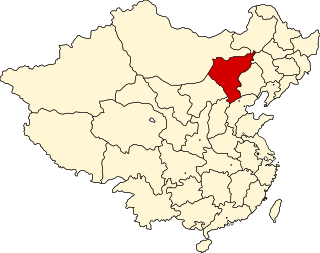Afghan Turkestan, also known as Southern Turkestan, is a region in northern Afghanistan, on the border with the former Soviet republics of Turkmenistan, Uzbekistan and Tajikistan. In the 19th century, there was a province in Afghanistan named Turkestan with Mazari Sharif as provincial capital. The province incorporated the territories of the present-day provinces of Balkh, Kunduz, Jowzjan, Sar-e Pol, and Faryab. In 1890, Qataghan-Badakhshan Province was separated from Turkestan Province. It was later abolished by Emir Abdur Rahman.

Chahar, also known as Chaha'er, Chakhar or Qahar, was a province of the Republic of China in existence from 1912 to 1936, mostly covering territory in what is part of Eastern Inner Mongolia. It was named after the Chahar Mongols.

Afghanistan is divided into 34 provinces. The provinces of Afghanistan are the primary administrative divisions. Each province encompasses a number of districts or usually over 1,000 villages.

Balkh is one of the 34 provinces of Afghanistan, located in the north of the country. It is divided into 15 districts and has a population of about 1,509,183, which is multi-ethnic and mostly a Persian-speaking society. The city of Mazar-i-Sharif serves as the capital of the province. The Mazar-i-Sharif International Airport and Camp Marmal sit on the eastern edge of Mazar-i-Sharif.

The districts of Afghanistan, known as wuleswali are secondary-level administrative units, one level below provinces. The Afghan government issued its first district map in 1973. It recognized 325 districts, counting wuleswalis (districts), alaqadaries (sub-districts), and markaz-e-wulaiyat. In the ensuing years, additional districts have been added through splits, and some eliminated through merges. In June 2005, the Afghan government issued a map of 398 districts. It was widely adopted by many information management systems, though usually with the addition of Sharak-e-Hayratan for 399 districts in total. It remains the de facto standard as of late 2018, despite a string of government announcements of the creation of new districts.
Sholgara is a district in the southern part of Balkh Province, Afghanistan. Sholgara, just south of Mazari Sharif (Mazar), is strategically located at the crossroads between several districts: Sangcharak, Kishindih, Dar-I-Suf. Dar-I-Suf and Sangcharak are known for their resistance to the Taliban insurgency. It is commonly said that "who holds Sholgara, holds Mazar".
Ahmad ibn Umar ibn Alī, known as Nizamī-i Arūzī-i Samarqandī and also Arudi, was a poet and prose writer who flourished between 1110 and 1161. He is particularly famous for his Chahar Maqala, his only work to fully survive. While living in Samarqand, Abu’l-Rajaʾ Ahmad b. ʿAbd-Al-Ṣamad, a dehqan in Transoxiana, told Nezami of how the poet Rudaki was given compensation for his poem extolling the virtues of Samanid Amir Nasr b. Ahmad.
Zari is a district in Balkh province, Afghanistan. It was created in 2005 from part of Kishindih district.
Charkint, or Chahar Kint, is a district in Balkh province, Afghanistan. It has a population of 32,306. The district administration is located in Shar Shar area of Charkint district, which means "four clusters/towns" - from Persian chahār, "four", and Sogdian kand, "town". The area of the district is 1,357 square kilometres (524 sq mi).
Chārbōlak district is located in the western part of Balkh Province. Its capital is the village of Charbolak, 40 km northwest of Mazari Sharif. The majority of the population is Pashtun.
Marmul is a small district, located in the central part of Balkh province in northern Afghanistan. The capital Marmul is in its southern end on the border with the Chahar Kint district.

Qalay-I-Zal District, also spelled Qala-i-Zal, is situated in the western part of Kunduz Province, northern Afghanistan. It borders Balkh Province to the west and Tajikistan to the north along the Panj, Vakhsh and Amu Darya rivers. To the east it borders Imam Sahib District and to the south Kunduz and Chahar dara districts. Qalay-I-Zal River flows through the district and divides it in two parts. The population is 60,600 (2006) - 60% Turkmen and 40% Pashtun. The district is almost a desert and only the irrigated land is arable. The agriculture and carpet weaving are the most important sources of income.
Chahar or Chakhar may refer to:
Chahar Kent is a village in Balkh Province in northern Afghanistan.
Chahar Mahalleh is a village in Balkh Province in northern Afghanistan.

North Padang Lawas is a regency in North Sumatra province of Indonesia. It has an area of 3,918.05 km2, and had a population of 223,049 at the 2010 census and 260,720 at the 2020 census; the official estimate as at mid 2022 was 267,275. North Padang Lawas Regency was created on 17 July 2007 from eastern parts of the South Tapanuli Regency. Its administrative seat is the town of Gunung Tua.

Bolak is a constructed language that was invented by Léon Bollack. The name of the language means both "blue language" and "ingenious creation" in the language itself.

The Afghan Border Force (ABF) was responsible for security of Afghanistan's border area with neighboring countries extending up to 30 miles (48 km) into the interior and formed part of the Afghan National Army. In December 2017, most of the Afghan Border Police (ABP) personnel of the Afghan National Police were transferred to the Afghan National Army to form the Afghan Border Force. The ABP retained 4,000 personnel for customs operations at border crossings and international airports such as checking documents of foreigners entering the country or deporting them.
Chahar Zabar-e Olya is a village in Mahidasht Rural District, Mahidasht District, Kermanshah County, Kermanshah Province, Iran. At the 2006 census, its population was 173, in 37 families.








